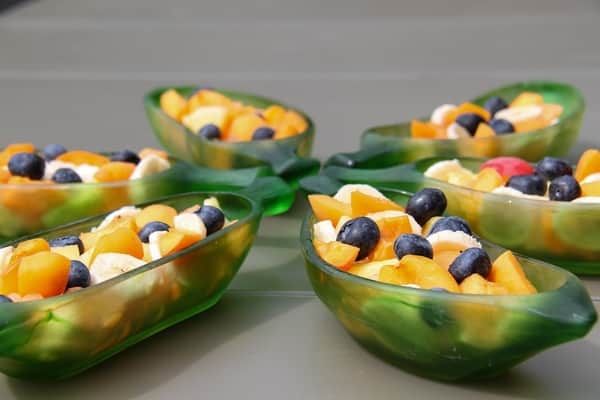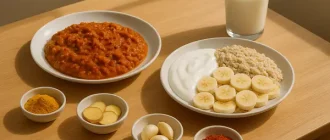High fiber content in food significantly improves the digestive process, prevents constipation, and improves metabolic processes in the body. In this article, we will look at the most common and available products in markets that are highest fiber compared to other foods.
Foods With Highest Fiber Chart
For clarity, we have compiled in the form of a chart the most popular high-fiber foods that are often found in our homes. If not, then the next time you visit the market, buy yourself these particular foods with the highest fiber content:
| Fruits | Serving size | Total fiber (grams)* |
|---|---|---|
| Raspberries | 1 cup | 8.0 |
| Pear | 1 medium | 5.5 |
| Apple, with skin | 1 medium | 4.5 |
| Banana | 1 medium | 3.0 |
| Orange | 1 medium | 3.0 |
| Strawberries | 1 cup | 3.0 |
| Vegetables | Serving size | Total fiber (grams)* |
|---|---|---|
| Green peas, boiled | 1 cup | 9.0 |
| Broccoli, boiled | 1 cup chopped | 5.0 |
| Turnip greens, boiled | 1 cup | 5.0 |
| Brussels sprouts, boiled | 1 cup | 4.0 |
| Potato, with skin, baked | 1 medium | 4.0 |
| Sweet corn, boiled | 1 cup | 3.5 |
| Cauliflower, raw | 1 cup chopped | 2.0 |
| Carrot, raw | 1 medium | 1.5 |
| Grains | Serving size | Total fiber (grams)* |
|---|---|---|
| Spaghetti, whole-wheat, cooked | 1 cup | 6.0 |
| Barley, pearled, cooked | 1 cup | 6.0 |
| Bran flakes | 3/4 cup | 5.5 |
| Quinoa, cooked | 1 cup | 5.0 |
| Oat bran muffin | 1 medium | 5.0 |
| Oatmeal, instant, cooked | 1 cup | 5.0 |
| Popcorn, air-popped | 3 cups | 3.5 |
| Brown rice, cooked | 1 cup | 3.5 |
| Bread, whole-wheat | 1 slice | 2.0 |
| Bread, rye | 1 slice | 2.0 |
| Legumes, nuts and seeds | Serving size | Total fiber (grams)* |
|---|---|---|
| Split peas, boiled | 1 cup | 16.0 |
| Lentils, boiled | 1 cup | 15.5 |
| Black beans, boiled | 1 cup | 15.0 |
| Baked beans, canned | 1 cup | 10.0 |
| Chia seeds | 1 ounce | 10.0 |
| Almonds | 1 ounce (23 nuts) | 3.5 |
| Pistachios | 1 ounce (49 nuts) | 3.0 |
| Sunflower kernels | 1 ounce | 3.0 |
Next, we will look at fruits, vegetables, berries and other fiber-fortified foods in more detail:
Pears
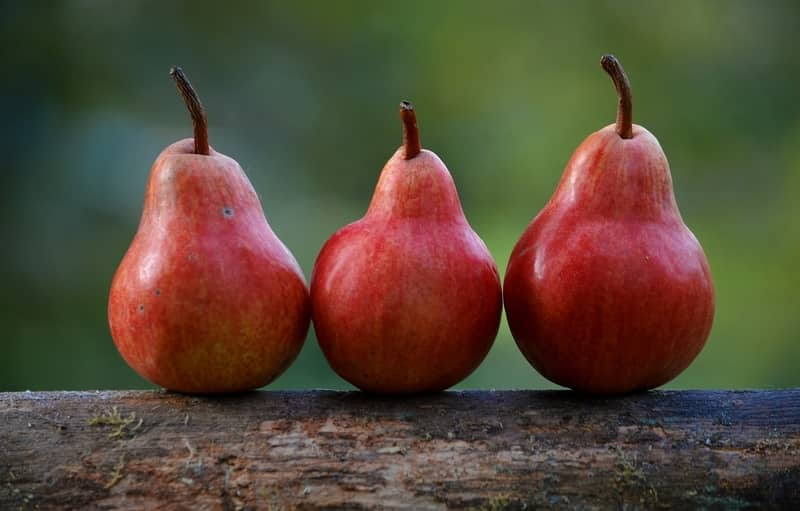
The pear is a popular kind of fruit that is both delicious and nutritious. It’s one of the best fruit sources of fiber.
Fiber content: 5.5 grams in a medium-sized pear, or 3.1 grams per 100 grams.
Strawberries
Strawberries are incredibly scrumptious. Plus, they’re a much healthier alternative than any scrap food.
Remarkably, they’re also amongst the most nutrient-dense fruits you can consume — loaded with vitamin C, manganese and different effective anti-oxidants.
Fiber content: 3 grams in one cup, or 2 grams per 100 grams. This is very high offered their low calorie content.
Carrots
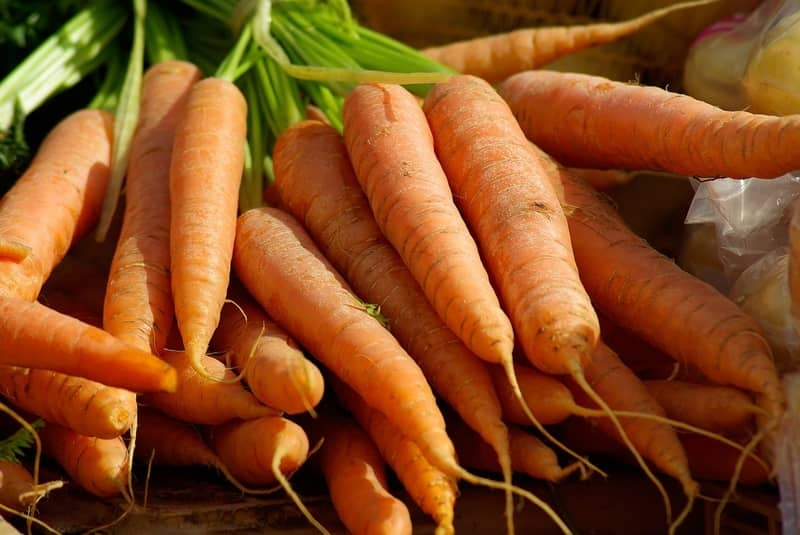
The carrot is a root vegetable that is delicious, crispy and highly nutritious.
It’s high in vitamin K, vitamin B6, magnesium and beta-carotene, an antioxidant that gets become vitamin A in your body.
Fiber content: 3.6 grams in one cup, or 2.8 grams per 100 grams. This is very high given their low calorie content.
Broccoli
Broccoli is a kind of cruciferous vegetable and one of the most nutrient-dense foods in the world.
It is loaded with vitamin C, vitamin K, folate, B vitamins, potassium, iron and manganese and contains anti-oxidants and potent cancer-fighting nutrients.
Broccoli is also fairly high in protein, compared to most vegetables.
The high amount of soluble fiber in broccoli can support your gut health by feeding the good bacteria in your large intestine.
Fiber content: 2.4 grams per cup, or 2.6 grams per 100 grams.
Avocado
The avocado is various from a lot of fruits. Instead of being high in carbs, it’s packed with healthy fats.
Avocados are very high in vitamin C, potassium, magnesium, vitamin E and various B vitamins. They likewise have numerous health advantages.
Fiber content: 10 grams in a cup, or 6.7 grams per 100 grams.
Apples
Apples are among the tastiest and most rewarding fruits you can eat. They are likewise relatively high in fiber.
Fiber content: 4.4 grams in a medium-sized apple, or 2.4 grams per 100 grams.
Raspberries
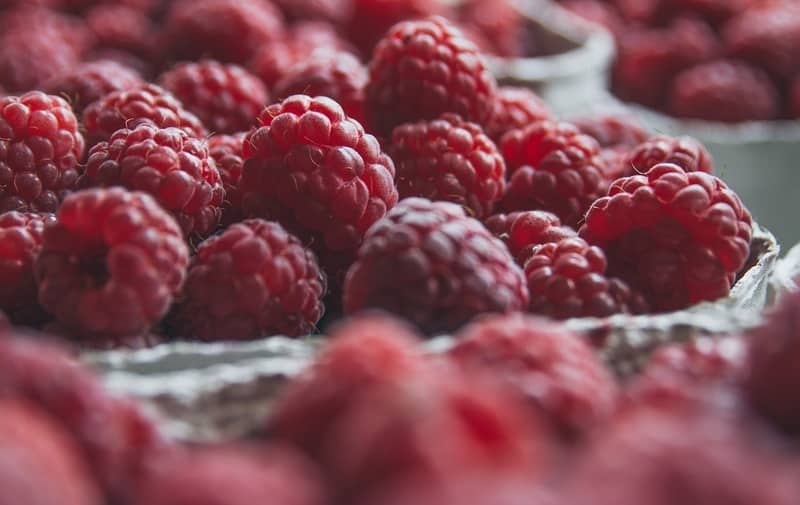
Raspberries are highly healthy with a very strong taste. They’re filled with vitamin C and manganese.
Fiber content: One cup contains 8 grams of fiber, or 6.5 grams per 100 grams.
Bananas
Bananas are a good source of lots of nutrients, including vitamin C, vitamin B6 and potassium.
A green or unripe banana likewise contains a significant quantity of resistant starch, a type of indigestible carb that functions like fiber.
Bananas, rich in potassium and fiber and low in sodium, are an important component of heart-healthy diets.
Fiber content: 3.1 grams in a medium-sized banana, or 2.6 grams per 100 grams.
Artichoke
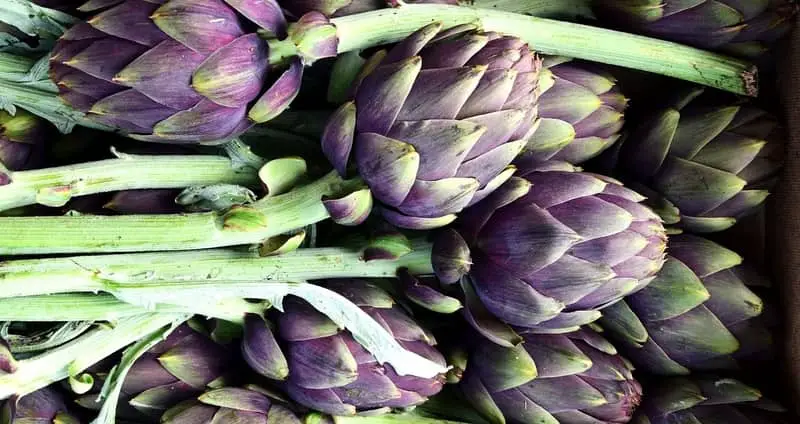
The artichoke doesn’t make headings very frequently. However, this veggie is high in lots of nutrients and among the world’s finest sources of fiber.
Fiber content: 10.3 grams in one artichoke, or 8.6 grams per 100 grams.
Quinoa
Quinoa is a pseudo-cereal that has actually become extremely popular among health-conscious people in the last few years.
It’s packed with lots of nutrients, consisting of protein, magnesium, iron, zinc, potassium and antioxidants, to call a couple of.
Fiber content: 5.2 grams per cup of cooked quinoa, or 2.8 per 100 grams.
Oats
Oats are amongst the healthiest grain foods in the world. They’re very high in vitamins, minerals and antioxidants.
They contain a powerful soluble fiber called oat beta-glucan, which has significant helpful effects on blood sugar level and cholesterol levels.
Oats contain complex carbohydrates that are full of fiber and nutrients that fuel the body and give sustained energy.
Fiber content: 16.5 grams per cup of raw oats, or 10.6 grams per 100 grams.
Brussels Sprouts
The Brussels grow is a type of cruciferous veggie that is associated to broccoli.
They’re very high in vitamin K, potassium, folate and powerful cancer-fighting anti-oxidants.
Fiber content: 4 grams per cup, or 2.6 grams per 100 grams.
Nearly all veggies contain significant quantities of fiber. Other significant examples consist of kale (3.6%), spinach (2.2%) and tomatoes (1.2%).
Beets
The beet, or beetroot, is a root veggie that is high in various essential nutrients, such as folate, iron, copper, manganese and potassium.
Beets are likewise packed with inorganic nitrates, which are nutrients revealed to have various benefits related to high blood pressure policy and exercise performance.
Fiber content: 3.8 grams per cup, or 2.8 grams per 100 grams.
Lentils
Lentils are very cheap and amongst the most healthy foods on earth. They’re very high in protein and loaded with lots of crucial nutrients.
Fiber content: 15.6 grams per cup of cooked lentils, or 7.9 per 100 grams.
Kidney Beans
Kidney beans are a popular type of vegetable. Like other legumes, they’re packed with plant-based protein and various different nutrients.
Fiber content: 11.3 grams per cup of prepared beans, or 6.4 per 100 grams.
Split Peas
Split peas are made from the dried, split and peeled seeds of peas. Split peas are high in phytates, which may be the most crucial variable governing the frequency of colon cancer, and may likewise have protective effects versus osteoporosis.
The safest form of iron (“non-heme iron”) is discovered in split peas, other beans, and in several kinds of fruits, vegetables, nuts, and seeds. Split peas and other whole foods consist of magnesium, which may positively impact some metabolic and inflammatory disorders, including diabetes and heart problem.
Fiber content: 16.3 grams per cup of cooked split peas, or 8.3 per 100 grams.
Chickpeas
The chickpea is another type of legume that’s filled with nutrients, consisting of minerals and protein.
Fiber content: 12.5 grams per cup of cooked chickpeas, or 7.6 per 100 grams.
The majority of beans are high in protein, fiber and various nutrients. When properly prepared, they’re among the world’s most affordable sources of quality nutrition.
Other high-fiber legumes consist of black beans (8.7%), edamame (5.2%), lima beans (5.3%) and baked beans (5.5%).
Popcorn
If your goal is to increase your fiber consumption, popcorn may be the best treat you can consume.
Air-popped popcorn is very high in fiber, calorie for calorie. Nevertheless, if you add a great deal of fat, then the fiber-calorie ratio will be reduced considerably.
As an entire grain, popcorn is high in fiber, which benefits gastrointestinal health and promoting regular bowel movements.
According to the United States Department of Agriculture (USDA), a normal 3-cup or 24-gram (g) serving of air-popped popcorn consists of 3.5 g of fiber. The advised daily consumption for the typical individual in the U.S. is more than 25 g a day, and most individuals do not reach these levels.
Fiber content: 1.2 grams per cup of air-popped popcorn, or 14.5 grams per 100 grams.
Almonds
Almonds are a popular type of tree nut.
They’re very high in numerous nutrients, consisting of healthy fats, vitamin E, manganese and magnesium.
A 2017 research study released in Nutrition Journal found that Americans, especially kids, who changed treat foods with almonds or other tree nuts saw a significant increase in consumption of nutrients. In the study of more than 17,000 kids and adults, participants switched all their treats with almonds and. Scientists discovered that individuals consumed fewer empty calories, solid fats, sodium, hydrogenated fats, carbs and sugarcoated. Good oils and fats increased significantly, as did magnesium, fiber and protein by a little margin.
Fiber content: 3.4 grams per ounce, or 12.5 grams per 100 grams.
Chia Seeds
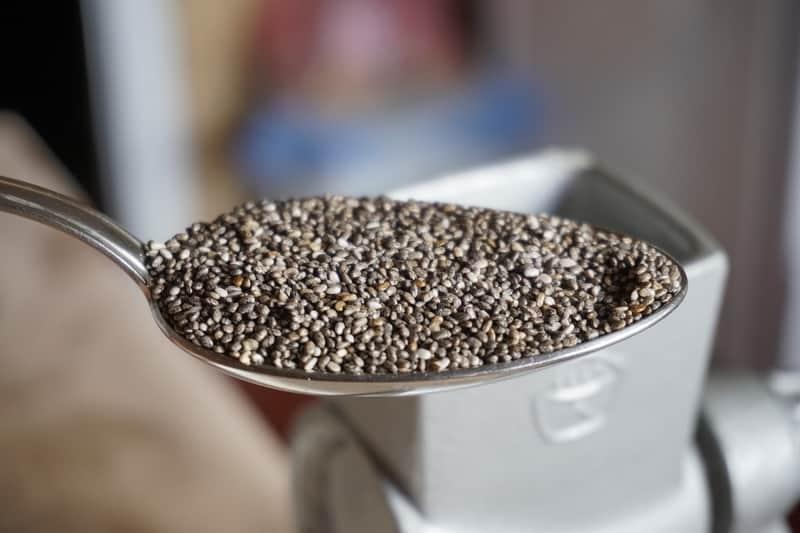
Chia seeds are small black seeds that are exceptionally popular in the natural health neighborhood.
They’re highly nutritious, containing high amounts of magnesium, phosphorus and calcium.
Chia seeds may also be the single best source of fiber in the world.
Fiber content: 10.6 grams per ounce of dried chia seeds, or 34.4 grams per 100 grams.
The majority of nuts and seeds contain substantial quantities of fiber. Examples consist of coconuts (9%), pistachios (10%), walnuts (7%), sunflower seeds (8.6%) and pumpkin seeds (18.4%).
Sweet Potatoes
The sweet potato is a popular root that is very filling and has a delicious sweet flavor. It’s very high in beta-carotene, B vitamins and different minerals.
Are sweet potatoes better for you than spuds? While sweet potatoes are significantly higher in vitamin A and slightly greater in fiber, the potato wins when it comes to potassium and vitamin C content. Both white and sweet potatoes count as nutrient-dense foods. Switch it up and get the benefits of both.
Fiber content: A medium-sized boiled sweet potato (without skin) has 3.8 grams of fiber, or 2.5 grams per 100 grams.
Dark Chocolate
Dark chocolate is arguably among the world’s most delicious foods.
It’s also surprisingly high in nutrients and one of the most antioxidant-rich and nutrient-dense foods on earth.
Simply ensure to pick dark chocolate that has a cocoa content of 70-95% or greater and avoid items packed with included sugar.
Research studies pointed out in an article released in the journal Frontiers in Pharmacology in addition noted that throughout digestion, chocolate acts like a prebiotic (not to be puzzled with probiotic), a type of fiber that motivates the growth of helpful bacteria in the gut. The more “good” microorganisms are in your system, the better your body is able to absorb nutrients in addition to support a healthy metabolic process, according to the Harvard T.H. Chan School of Public Health.
Fiber content: 3.1 grams in a 1-ounce piece, or 10.9 grams per 100 grams.
Our Verdict
Now it becomes clear to you that there are quite a lot of foods with highest fiber, so everyone can choose a list of products that can fill your daily diet with enough fiber.
About the Author
Reyus Mammadli is the author of this health blog since 2008. With a background in medical and biotechnical devices, he has over 15 years of experience working with medical literature and expert guidelines from WHO, CDC, Mayo Clinic, and others. His goal is to present clear, accurate health information for everyday readers — not as a substitute for medical advice.

